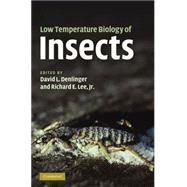
Low Temperature Biology of Insects
by Edited by David L. Denlinger , Richard E. Lee, Jr-

This Item Qualifies for Free Shipping!*
*Excludes marketplace orders.
Buy New
Rent Textbook
Used Textbook
We're Sorry
Sold Out
eTextbook
We're Sorry
Not Available
How Marketplace Works:
- This item is offered by an independent seller and not shipped from our warehouse
- Item details like edition and cover design may differ from our description; see seller's comments before ordering.
- Sellers much confirm and ship within two business days; otherwise, the order will be cancelled and refunded.
- Marketplace purchases cannot be returned to eCampus.com. Contact the seller directly for inquiries; if no response within two days, contact customer service.
- Additional shipping costs apply to Marketplace purchases. Review shipping costs at checkout.
Summary
Author Biography
Table of Contents
| List of contributors | p. vii |
| Preface | p. xi |
| Physiological and Molecular Responses | |
| A primer on insect cold-tolerance | p. 3 |
| Rapid cold-hardening: Ecological significance and underpinning mechanisms | p. 35 |
| Antifreeze and ice-nucleator proteins | p. 59 |
| Genomics, proteomics and metabolomics: Finding the other players in insect cold-tolerance | p. 91 |
| Cell structural modifications in insects at low temperatures | p. 116 |
| Oxygen: Stress and adaptation in cold-hardy insects | p. 141 |
| Interactions between cold, desiccation and environmental toxins | p. 166 |
| Ecological and Evolutionary Responses | |
| The macrophysiology of insect cold-hardiness | p. 191 |
| Evolutionary physiology of insect thermal adaptation to cold environments | p. 223 |
| Insects at not so low temperature: Climate change in the temperate zone and its biotic consequences | p. 242 |
| Genetic variability and evolution of cold-tolerance | p. 276 |
| Life-history adaptations to polar and alpine environments | p. 297 |
| Practical Applications | |
| A template for insect cryopreservation | p. 325 |
| Implications of cold-tolerance for pest management | p. 342 |
| Index | p. 374 |
| Table of Contents provided by Ingram. All Rights Reserved. |
An electronic version of this book is available through VitalSource.
This book is viewable on PC, Mac, iPhone, iPad, iPod Touch, and most smartphones.
By purchasing, you will be able to view this book online, as well as download it, for the chosen number of days.
Digital License
You are licensing a digital product for a set duration. Durations are set forth in the product description, with "Lifetime" typically meaning five (5) years of online access and permanent download to a supported device. All licenses are non-transferable.
More details can be found here.
A downloadable version of this book is available through the eCampus Reader or compatible Adobe readers.
Applications are available on iOS, Android, PC, Mac, and Windows Mobile platforms.
Please view the compatibility matrix prior to purchase.